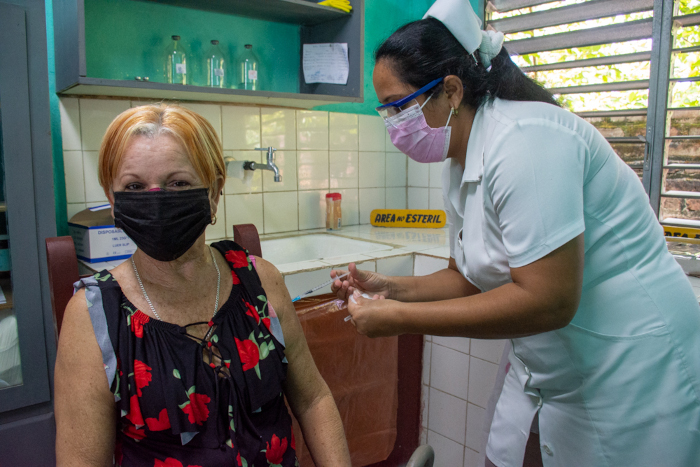CAMAGÜEY.- While the sanitary intervention with the Abdala vaccine continues in the municipalities of Carlos Manuel de Céspedes and Florida, with the first dose, and Camagüey, about to conclude the second, the epidemiological situation in the province of Camagüey worries about its complexity with a rate incidence of COVID-19 of more than 500 cases per 100,000 inhabitants.
The application of the first dose of the Abdala vaccine in the towns of Carlos Manuel de Céspedes and Florida is at 90%. In these, immunization is carried out by blocks and different age groups at the same time, to achieve greater agility. Meanwhile, in Nuevitas it began with the Home for the Elderly.
The second dose has already been given to more than 80% of the planned citizens in the main municipality. There, the first covers 99.7% of the population to be vaccinated and the recovery of those who, due to illness or being a contact with a confirmed case of COVID-19, did not start that cycle, added Sonia María González Vega, head of the Primary Care section in the territory.
In the coming days, the vaccination of pregnant women in the second and third trimesters and women who breastfeed will begin, in total there will be about 5,000.
In addition, the pediatric trial with Abdala in the Ignacio Agramonte and Julio Antonio Mella polyclinics will be extended to children between 3 and 12 years old, a preliminary step to extend it to the almost 600 children and adolescents included in the Ismaelillo study.
Specialists consider that as the immunization process of the population progresses, the complex epidemiological situation facing the province could be reversed, but they call on the population to contribute in the fulfillment of the sanitary and hygienic measures oriented, with emphasis on physical distancing and the use of a mask.
The incidence rate of the COVID-19 virus in the province amounts to more than 500 cases per 100,000 inhabitants. Although in recent days the trend has been to stability, the plateau is about very high numbers.
All municipalities have autochthonous cases in the last 14 days. They present rates above 200, those of Carlos Manuel de Céspedes, Florida, Camagüey, Vertientes, Minas, Esmeralda, Najasa, Sierra de Cubitas, Sibanicú, Jimaguayú and Nuevitas.
The territories with a more complex situation are Céspedes, with 745 natives and a rate of 3,216.5, the highest in the country; Florida, with 643 cases and a rate of 920, and Camagüey, with 1,890 and 569.9 per 100,000.
In the first 21 days of July, 6,197 positives were diagnosed, with an average of 295 cases per day. The month accumulates 69 deaths until the 20th, averaging 3.4 deaths per day. The fatality rate decreases from 1.8% in May to 0.9% in June, and currently stands at 1.2%. The age group from 60 to 81 is the one with the most deaths (23), followed by the age group from 40 to 59, with 20.
Among the comorbidities that have caused major complications and death are arterial hypertension, diabetes, obesity and ischemic heart disease, and the direct cause of death that affects the most is pulmonary thromboembolism. It also directly affects the loss of opportunities due to late arrival to the Health system, 39 patients did so after the second day after the symptoms began.
Juan Jesús Llambías Peláez, director of the Provincial Center for Hygiene, Epidemiology and Microbiology, explained that vaccination should have an impact on these numbers, so as immunization progresses, the situation in the province will change. But the best way to take care of yourself continues to be the application of measures that have been shown to be effective against the disease: physical distancing, use of a mask and frequent hand washing.
Translated by Linet Acuña Quilez

